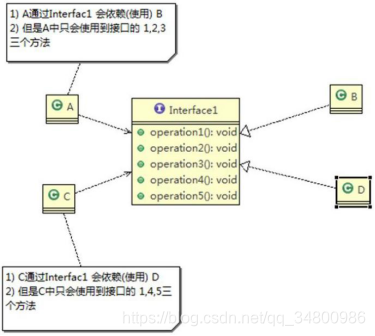上一篇概述了java设计原则和设计模式,并详细介绍了单一职责原则,本章将详解另外一个设计原则——接口隔离原则(Interface Segregation Principle)。
基本介绍
1)客户端不应该依赖它不需要的接口,即一个类对另一个类的依赖应该建立在最小的接口上
2)先看一张图:

3)类 A 通过接口 Interface1 依赖类 B,类 C 通过接口 Interface1 依赖类 D,如果接口 Interface1 对于类 A 和类 C
来说不是最小接口,那么类 B 和类 D 必须去实现他们不需要的方法。
4)按隔离原则应当这样处理:
将接口 Interface1 拆分为独立的几个接口(这里我们拆分成 3 个接口),类 A 和类 C 分别与他们需要的接口建立依赖关系。也就是采用接口隔离原则
应用实例
1)类 A 通过接口 Interface1 依赖类 B,类 C 通过接口 Interface1 依赖类 D。
2)看没有使用接口隔离原则代码
public class Segregation1 {
public static void main(String[] args) {
// TODO Auto-generated method stub
}
}
//接口
interface Interface1 {
void operation1();
void operation2();
void operation3();
void operation4();
void operation5();
}
class B implements Interface1 {
public void operation1() {
System.out.println("B 实现了 operation1");
}
public void operation2() {
System.out.println("B 实现了 operation2");
}
public void operation3() {
System.out.println("B 实现了 operation3");
}
public void operation4() {
System.out.println("B 实现了 operation4");
}
public void operation5() {
System.out.println("B 实现了 operation5");
}
}
class D implements Interface1 { public void operation1() {
System.out.println("D 实现了 operation1");
}
public void operation2() {
System.out.println("D 实现了 operation2");
}
public void operation3() {
System.out.println("D 实现了 operation3");
}
public void operation4() {
System.out.println("D 实现了 operation4");
}
public void operation5() { System.out.println("D 实现了 operation5");
}
}
class A { //A 类通过接口 Interface1 依赖(使用) B 类,但是只会用到 1,2,3 方法
public void depend1(Interface1 i) { i.operation1();
}
public void depend2(Interface1 i) { i.operation2();
}
public void depend3(Interface1 i) { i.operation3();
}
}
class C { //C 类通过接口 Interface1 依赖(使用) D 类,但是只会用到 1,4,5 方法
public void depend1(Interface1 i) { i.operation1();
}
public void depend4(Interface1 i) { i.operation4();
}
public void depend5(Interface1 i) { i.operation5();
}
}
应对传统方法的问题和使用接口隔离原则改进
1)类 A 通过接口 Interface1 依赖类 B,类 C 通过接口 Interface1 依赖类 D,如果接口 Interface1 对于类 A 和类 C来说不是最小接口,那么类 B 和类 D 必须去实现他们不需要的方法
2)将接口 Interface1 拆分为独立的几个接口,类 A 和类 C 分别与他们需要的接口建立依赖关系。也就是采用接口隔离原则
3)接口 Interface1 中出现的方法,根据实际情况拆分为三个接口

4)代码实现
public class Segregation1 {
public static void main(String[] args) {
A a = new A();
a.depend1(new B()); // A 类通过接口去依赖 B 类
a.depend2(new B());
a.depend3(new B());
C c = new C();
c.depend1(new D()); // C 类通过接口去依赖(使用)D 类
c.depend4(new D());
c.depend5(new D());
}
}
// 接 口 1
interface Interface1 {
void operation1();
}
// 接 口 2
interface Interface2 {
void operation2();
void operation3();
}
// 接 口 3
interface Interface3 {
void operation4();
void operation5();
}
class B implements Interface1, Interface2 {
public void operation1() {
System.out.println("B 实现了 operation1");
}
public void operation2() {
System.out.println("B 实现了 operation2");
}
public void operation3() {
System.out.println("B 实现了 operation3");
}
}
class D implements Interface1, Interface3 {
public void operation1() {
System.out.println("D 实现了 operation1");
}
public void operation4() {
System.out.println("D 实现了 operation4");
}
public void operation5() {
System.out.println("D 实现了 operation5");
}
}
class A { // A 类通过接口 Interface1,Interface2 依赖(使用) B 类,但是只会用到 1,2,3 方法
public void depend1(Interface1 i) {
i.operation1();
}
public void depend2(Interface2 i) {
i.operation2();
}
public void depend3(Interface2 i) {
i.operation3();
}
}
class C { // C 类通过接口 Interface1,Interface3 依赖(使用) D 类,但是只会用到 1,4,5 方法
public void depend1(Interface1 i) {
i.operation1();
}
public void depend4(Interface3 i) {
i.operation4();
}
public void depend5(Interface3 i) {
i.operation5();
}
}
